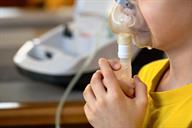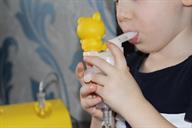How to Use a Nebulizer, Pediatric

A nebulizer is a device that turns liquid medicine into a vapor, or mist, that you can breathe in (inhale). Your child may need to use a nebulizer if he or she has a breathing condition, such as asthma or pneumonia.
There are different kinds of nebulizers. With some, your child breathes in through a mouthpiece. With others, a mask fits over your child's nose and mouth. The kind of nebulizer your child will use depends on his or her age. It is important that your child use the type that his or her health care provider recommends. Follow any special instructions that come with the device.
What are the risks?
Using a nebulizer that does not fit right or is not cleaned properly can cause problems, including:
Supplies needed:
-
Air compressor (nebulizer machine).
-
Nebulizer medicine cup (reservoir)and tubing.
-
Mouthpiece or face mask.
-
Soap and water.
-
Sterile or distilled water.
-
Clean towel.
How to use a nebulizer
Before using the nebulizer
Take these steps before using the nebulizer:
Read the manufacturer's instructions for your child's nebulizer, as machines vary.
Prepare a calm space for your child. You may want to have a favorite book, a quiet game, or a television program to engage your child during the treatment.
Check your child's medicine. Make sure it has not expired and is not damaged in any way.
Wash your hands with soap and water.
Put all the parts of the nebulizer on a sturdy, flat surface.
Connect the tubing to the nebulizer machine and to the reservoir.
Measure the liquid medicine according to instructions from your child's health care provider. Pour the medicine into the reservoir.
Attach the mouthpiece or mask.
Test the nebulizer by turning it on to make sure that a spray comes out. Then, turn it off.
The best time to use the nebulizer is when your child is calm. If your child is younger than one year old, the best time may be when your child is sleeping. If your child is crying when you use the nebulizer, the medicine will not reach deep enough into the lungs.
Using the nebulizer
Be sure to stop the machine at any time if your child starts coughing or if the medicine foams or bubbles.
Have your child sit in an upright, relaxed position.
Help your child relax if needed. You can do this by holding and comforting your child or having your child engage in a quiet activity.
- Do one of the following:
If your child uses a mask to get the medicine, place it over your child's nose and mouth. It should fit somewhat snugly, with no gaps around the nose or cheeks where medicine could escape.
If your child uses a mouthpiece to get the medicine, place it in your child's mouth and have your child press his or her lips firmly around the mouthpiece.
Turn on the nebulizer.
Once the medicine begins to mist out, have your child take slow and deep breaths in and out.
Have your child continue taking slow, deep breaths until the medicine in the nebulizer is gone and no mist appears. This takes 10–15 minutes.
If the medicine is a corticosteroid, and your child is old enough to do so, have him or her rinse and spit with water. If you child is too young to rinse his or her mouth, wipe the inside of the mouth and tongue with a wet cloth. If using a mask, wash the face as well.
Cleaning the nebulizer
The nebulizer and all its parts must be kept very clean. Without proper cleaning, bacteria can grow inside the nebulizer. If your child inhales the bacteria, he or she can get sick. Follow the manufacturer's instructions for cleaning your child's nebulizer. For most nebulizers, you should follow these guidelines:
- Clean the mouthpiece or mask and the reservoir by:
Do not wash the tubing.
After you rinse or wash them, place the parts on a clean towel and let them air-dry completely. After they dry, reconnect the pieces and turn the nebulizer on without any medicine in it. Doing this will blow air through the equipment to help dry it out.
Store the nebulizer in a clean and dust-free place.
Check the filter at least one time every week. Replace the filter if it looks dirty.
Follow these instructions at home
-
Use the nebulizer only as told by your child's health care provider. Do not use the nebulizer more than directed.
-
Keep all follow-up visits as told by your child's health care provider. This is important.
Contact a health care provider if:
-
Your child's breathing does not improve following the nebulizer treatment.
-
Your child's nebulizer stops working, foams, or does not create a mist after you add medicine and turn it on.
-
You have trouble using the nebulizer.
These symptoms may represent a serious problem that is an emergency. Do not wait to see if the symptoms will go away. Get medical help right away. Call your local emergency services (911 in the U.S.).
Summary
-
A nebulizer is a device that turns liquid medicine into a vapor, or mist, that you can breathe in (inhale).
-
Measure the liquid medicine according to instructions from your child's health care provider. Pour the medicine into the reservoir.
-
Once the medicine begins to mist out, have your child take slow and deep breaths.
-
Rinse or wash the mouthpiece or mask and the reservoir after each use. Allow them to air-dry completely.
This information is not intended to replace advice given to you by your health care provider. Make sure you discuss any questions you have with your health care provider.


